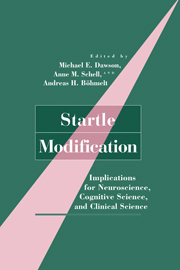Book contents
- Frontmatter
- Contents
- Contributors
- Preface
- Prologue: A Historical Note on the “Discovery” of Startle Modification
- 1 Startle Modification: Introduction and Overview
- PART I BASIC PARADIGMS, METHODS, AND PHENOMENA
- PART II PHYSIOLOGICAL MEDIATION OF STARTLE MODIFICATION
- PART III PSYCHOLOGICAL MEDIATION OF STARTLE MODIFICATION
- PART IV INDIVIDUAL DIFFERENCES AND STARTLE MODIFICATION
- 9 Affective Individual Differences, Psychopathology, and Startle Reflex Modification
- 10 Psychopathic Traits and Intoxicated States: Affective Concomitants and Conceptual Links
- 11 Schizophrenia Spectrum Disorders
- 12 Startle Modification in Children and Developmental Effects
- PART V RELATIONSHIPS WITH OTHER PARADIGMS AND MEASURES
- References
- Author Index
- Subject Index
9 - Affective Individual Differences, Psychopathology, and Startle Reflex Modification
Published online by Cambridge University Press: 26 March 2010
- Frontmatter
- Contents
- Contributors
- Preface
- Prologue: A Historical Note on the “Discovery” of Startle Modification
- 1 Startle Modification: Introduction and Overview
- PART I BASIC PARADIGMS, METHODS, AND PHENOMENA
- PART II PHYSIOLOGICAL MEDIATION OF STARTLE MODIFICATION
- PART III PSYCHOLOGICAL MEDIATION OF STARTLE MODIFICATION
- PART IV INDIVIDUAL DIFFERENCES AND STARTLE MODIFICATION
- 9 Affective Individual Differences, Psychopathology, and Startle Reflex Modification
- 10 Psychopathic Traits and Intoxicated States: Affective Concomitants and Conceptual Links
- 11 Schizophrenia Spectrum Disorders
- 12 Startle Modification in Children and Developmental Effects
- PART V RELATIONSHIPS WITH OTHER PARADIGMS AND MEASURES
- References
- Author Index
- Subject Index
Summary
ABSTRACT
Although affective modification of the startle reflex is a robust phenomenon, it does not occur universally. Research is reviewed suggesting that affective startle modification varies systematically in relation to affective trait dispositions and clinical diagnosis of anxiety, mood, and schizophrenia spectrum disorders. Evidence supports a reliable association between high trait fearfulness and enhanced startle modification by affective valence. Findings for other affective individual differences are thus far only suggestive. Despite the fact that much interest in startle stems from reports of exaggerated startle in posttraumatic stress disorder (PTSD), the precise pattern of startle reactivity and modification in this disorder remains uncertain. Nevertheless, recent studies of affective startle modification in PTSD, as well as in schizophrenia and depression, have yielded provocative results that may ultimately inform our understanding of these disorders. The review emphasizes the need to use a range of affect manipulations and modification paradigms, more powerful research designs, and more appropriate statistical comparisons in future research in this area.
Introduction
A decade has now passed since the original report of affective startle modification in humans (Spence, Vrana, & Lang, 1987), and startle potentiation during aversive compared with pleasant and/or neutral conditions has been repeatedly demonstrated. In one popular paradigm (e.g., Bradley, Cuthbert, & Lang, 1990, 1991, 1996), pictures evoke different affects, startle is elicited with brief noises, and the magnitude of the eyeblink startle response is measured.
- Type
- Chapter
- Information
- Startle ModificationImplications for Neuroscience, Cognitive Science, and Clinical Science, pp. 187 - 208Publisher: Cambridge University PressPrint publication year: 1999
- 13
- Cited by



